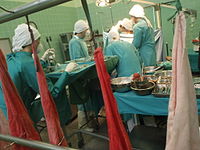
Photo from wikipedia
Liver transplantation (LT) is the only curative therapy in patients with end-stage liver disease. Long-term survival is excellent, yet LT recipients are at risk of significant complications. Biliary complications are… Click to show full abstract
Liver transplantation (LT) is the only curative therapy in patients with end-stage liver disease. Long-term survival is excellent, yet LT recipients are at risk of significant complications. Biliary complications are an important source of morbidity after LT, with an estimated incidence of 5%–32%. Post-LT biliary complications include strictures (anastomotic and non-anastomotic), bile leaks, stones, and sphincter of Oddi dysfunction. Prompt recognition and management is critical as these complications are associated with mortality rates up to 20% and retransplantation rates up to 13%. This review aims to summarise our current understanding of risk factors, natural history, diagnostic testing, and treatment options for post-transplant biliary complications.
Journal Title: BMJ Open Gastroenterology
Year Published: 2022
Link to full text (if available)
Share on Social Media: Sign Up to like & get
recommendations!